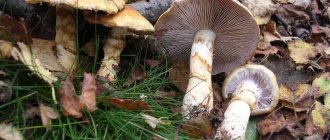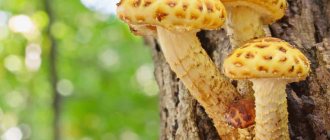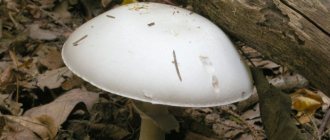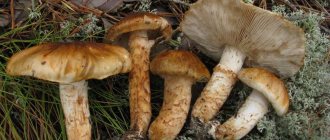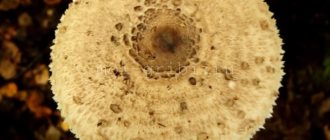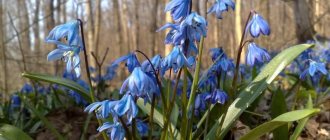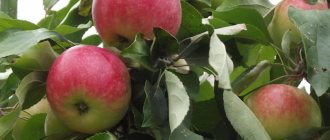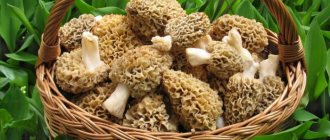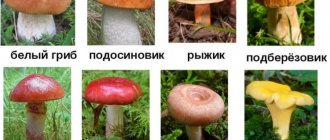The popular edible chanterelle mushroom (Cantharellus tubaeformis) belongs to the chanterelle family and is found by mushroom pickers in well-drained coniferous forests that receive sunlight.
Trumpet chanterelles are charming but not as well known as common chanterelles, which bear fruit earlier. Trumpet chanterelles are favored by the fact that mushrooms appear in hundreds of specimens, and if you find a mycelium, you won’t go home without a harvest.
Where do trumpet chanterelles grow?
Trumpet chanterelles are common in spruce forests on acidic soil and bear fruit in colonies. In mainland Europe, the mushroom is more common in northern latitudes; in countries located closer to the south, trumpet chanterelles grow on forested hills.
Once you find a forest with Cantharellus tubaeformis, it will not be difficult to collect mushrooms for food. Thanks to their delicate taste and pleasant firm texture, trumpet chanterelles have won the liking of wild mushroom cooks.
Taxonomic history
The name Cantharellus tubaeformis was given and described by the Swede Elias Magnus Fries in 1821. In Sweden, a soup is prepared from the mushroom in a pot; the Swedes call the trumpet chanterelle Trattkanterell.
The generic name Cantharellus comes from the Latin word cantharus - a vessel, bowl or drinking cup with handles. The word tubaeformis means "hollow tube shape".
Cooking recipes
Chanterelles are considered valuable mushrooms. During the cooking process they acquire a noble nutty taste. They practically do not change their color, turning a little brown in the marinade. Cooking trumpet chanterelle is a pleasure!
Primary processing
Collect only young specimens without significant defects from the forest. It is better to place small fruits on top of the basket so that larger mushrooms do not crush them.
How to properly clean chanterelles:
- When going mushroom hunting, be sure to take a pocket knife with you. It is useful not only for collecting fruits: it is used to clean dirt on chanterelles right in the forest.
- When you come home, remove the blades of grass from the caps and myceliums.
- Rinse and use for cooking.
Cooking
To quickly begin the main preparation of mushrooms, you need to first boil them and drain the water. There is a second way to remove bitterness, but it will take longer - soak the fruits for 4-5 hours in cold water.
You will need:
- 1 kg chanterelles;
- 0.5 tsp. salt;
- 5 black peppercorns;
- clove of garlic.
Preparation:
- Cut the mushrooms into pieces.
- Place the chanterelles in a saucepan and cover with cold water.
- Add all the seasonings there.
- When the water boils, set aside 15–20 minutes.
- Drain the liquid through a colander.
Pickling
Before marinating, you need to boil the chanterelles for 20 minutes. Drain the liquid and put the pan of water back on the fire. When the liquid boils, lower the fruiting bodies into boiling water.
Products:
- 1 kg chanterelles;
- 1 liter of water;
- 0.5 tsp. granulated sugar;
- 0.5 tsp. salt;
- 1 bay leaf;
- 5–6 clove inflorescences;
- 3 black peppercorns;
- 1 tbsp. l. 9% vinegar.
How to pickle chanterelles:
- When the fruiting bodies are already in boiling water, add all the spices (except vinegar). Boil the marinade for 5 minutes.
- Pour a tablespoon of vinegar into the pan and turn off the gas.
- Pour into clean jars.
- Roll up. Store in a cool, dark place.
Freezing
Please note that chanterelles should not be washed before freezing. Further actions:
- Clean the mushrooms with a knife and dry cloths to remove any dirt.
- Cut into thin slices.
- Place on a tray and place in the freezer for 4 hours.
- Take out the workpiece and distribute it into bags.
- Store chanterelles in the freezer.
Frying
Before frying the mushrooms, soak them in cold water for 4 hours, then start cooking.
Products:
- 1 onion;
- 500 g chanterelles;
- 0.5 tsp. salt;
- ground black pepper (to taste);
- 3 tbsp. l. sunflower oil.
Recipe:
- After soaking, dry the fruiting bodies with a dry cloth.
- Cut the onion and chanterelles into strips.
- Heat a frying pan with sunflower oil. Put all the ingredients in it.
- Fry over high heat until golden brown.
- Cover the pan with a lid. Simmer until done (about 10 minutes).
Pickling
Tubular mushrooms are the best material for sowing. Choose exclusively young and elastic mushrooms of small size. Overgrown specimens become flabby during cooking and do not crisp.
Preparing chanterelles for salting:
- Process the fruits.
- Make a solution in a bowl: dilute 10 g of salt and 2 g of citric acid in 2 liters of water. Pour in the mushrooms and leave them in the container for 5 hours.
- After soaking, boil the chanterelles twice to remove the bitterness. The first time, fill them with cold water, bring to a boil, and drain the liquid. The second time - put it in boiling water and boil for 20 minutes.
Cold pickling helps preserve mushrooms and enjoy them all winter long. It is important that the jars with the preparations are in a cool place.
Ingredients:
- 1 kg of mushrooms;
- 80 g salt;
- 3 tbsp. l. vegetable oil;
- 5 dill umbrellas;
- 2 heads of garlic.
Preparation:
- If you don’t want to waste time on cooking, you can simply scald the peeled chanterelles with boiling water.
- Place a sprig of dill and a little garlic in the jar.
- Place the mushrooms in layers and add salt.
- Place the remaining garlic and dill on top.
- Press down the workpiece with pressure and place it in a cool place for 24 hours.
- Pour sunflower oil over the cold-seasoned chanterelles and cover tightly with a lid.
Salted mushroom is ideal for making soups, salads, and filling for pies.
Ingredients:
- 1 kg chanterelles;
- 6 cloves of garlic;
- 5 pieces. bay leaves;
- 3 pcs. carnations;
- 5 tsp. coarse salt;
- 10 black peppercorns (you can use allspice).
How to pickle:
- Place a pinch of salt, spices (except garlic), and mushrooms in a large saucepan. Fill with water.
- Place over medium heat, cook for 15–20 minutes.
- During the cooking process, foam will form. Remove it with a slotted spoon.
- Place the boiled mushrooms (along with the brine) in sterile jars. It is important that the chanterelles are completely covered with liquid.
- Place a weight on top and put the workpiece in a cool place.
- After a day, pickled mushrooms can be eaten. If you are going to store them in winter, you can roll them up with a sterile lid.
Helpful advice! To ensure that the pickling is ready as quickly as possible, the mushrooms are cut into small pieces.
Oven drying
It is most convenient to dry chanterelles using the oven. This way you will provide yourself with delicious food for a whole 12 months.
Progress:
- Clean the mushrooms from dirt using a dry method.
- Cut the chanterelles into slices.
- Cover a baking sheet with parchment, place the pieces on top (they should not touch each other, they should be dried at a distance of 1-2 cm).
- Preheat the oven to 50°C and place a baking tray. Leave the door ajar.
- After 1.5 hours, increase the temperature to 60 °C.
- After 60 minutes, remove the baking sheet and check the readiness of the fruiting bodies with a fork. Dried mushroom should be plastic and dry.
- Ready chanterelles can be removed from the oven and poured into clean glass jars for storage.
Attention! Cooking time can vary within 15–20 minutes. The thinner you cut the slices, the faster they dry.
Canning for the winter
Having prepared forest fruits for future use, you will be able to brighten up your winter dinner with aromatic mushrooms. We recommend cooking chanterelles in lemon juice in Finnish style.
Products:
- 2 kg of mushrooms;
- 1 liter of water;
- 70 g salt;
- 150 g sugar;
- 7 pcs. carnation;
- 10 peas of black or allspice;
- 9 tbsp. l. lemon juice.
The Finnish recipe consists of the following steps:
- Rinse the chanterelles well and cover with water.
- Bring to a boil, boil the mushrooms for about 15 minutes. Drain the liquid.
- Prepare a brine from water, sugar, pepper, cloves, and salt. When it boils, add the chanterelles and cook for 10 minutes.
- Pour in lemon juice and stir the contents of the pan well. Simmer the mushrooms over low heat for 5-7 minutes.
- Remove the container from the heat and place the ingredients into jars. After rolling, place the workpiece with the lids down. When the contents have cooled, you need to put the preservation in a dark place.
- Chanterelles are ready to eat a month after preparation.
Prepare chanterelles canned in tomato - this delicious appetizer will delight not only you, but all your guests!
Ingredients:
- 2 kg of mushrooms;
- 1 kg of onion;
- 300 g tomato paste;
- 1 tbsp. water;
- vegetable oil;
- 5 tsp. salt;
- 1 tsp. ground black pepper;
- 1 tsp. garlic, passed through a press;
- 4 bay leaves;
- 3 tbsp. l. vinegar 9%.
Preparation:
- Boil the fruits for 15–20 minutes in water with a pinch of salt.
- Drain the chanterelles through a colander.
- Fry the onion in a frying pan until golden brown.
- Cut the mushrooms into small slices and place in a frying pan.
- Add all the spices (except vinegar), fry over moderate heat for 60 minutes. Before adding tomato paste, dilute it a little with water.
- Stir the mixture occasionally to avoid burning.
- Pour in vinegar. Keep the heat on for another 15 minutes.
- The cans are rolled up by turning them upside down. After the canned food has cooled, move it to a dark, cool room.
Appearance
hat
From 2 to 5 cm in diameter, thin flesh, brown above with a pale edge, streaked below, funnel-shaped, with a wavy edge.
Veins
Initially yellow, they become grayish as they mature, with wrinkled veins branching out and straightening out. There are also cross veins under the cap.
Leg
Tall, somewhat flattened and hollow, 5 to 10 mm in diameter and often slightly clubbed or convex at the base. The smell/taste is not distinctive.
Collection rules
The collection season for trumpet (funnel-shaped) chanterelles begins in August-September and lasts until the onset of winter.
What is important to know when collecting this variety:
- The mushroom often hides among the moss and grass, and this complicates its search.
- Due to the characteristic feature of the tubular (funnel-shaped) chanterelle to form mycorrhiza with both hard and soft species of trees and conifers, it is worth paying attention to rotten wood, as well as looking for the yellow beauty under pines and spruces.
- Funnel-shaped representatives of Chanterelles, located in groups, often form so-called witch circles.
- In addition, this variety does not need to be immediately checked for the presence of worms: they simply do not exist in it. This is another advantage of tubular (funnel-shaped) chanterelles, among which it is difficult to find undermined and spoiled mushrooms.
Trumpet chanterelle look-alikes
The trumpet chanterelle has no clearly defined false analogues. If the rules for collecting and identifying the species are followed, there is no chance of harvesting a poisonous crop. The tube-shaped chanterelle resembles the common chanterelle, but it is bright yellow, the cap is larger in diameter and more squat, the leg is hard, the flesh is pale with a slight fruity (apricot) smell.
Common chanterelle
Edibility
This edible mushroom is considered a delicacy due to its unique taste and belongs to the 2nd taste category. It is used to cook soups, prepare mushroom powder, sauces, freeze for the winter, fry, pickle or dry. The mushroom does not need pre-boiling; you can fry it immediately.
It is best to boil the trumpet chanterelle well so that the flesh becomes tender and soft. In general, its taste qualities are almost no different from those of an ordinary chanterelle.
It is very pleasant to collect representatives of this species. Yes, they are difficult to find, but they grow in large quantities. Moreover, worms do not like them, and therefore the mushrooms are always clean.
Useful and healing properties
Eating mushrooms collected in an ecologically clean place, located away from busy highways, popular forest paths, etc., will have a beneficial effect on the functioning of both the female and male body.
Health benefits of chanterelles:
- Thanks to the vitamin D contained in mushrooms, the functioning of the musculoskeletal system improves and bones are strengthened. In addition, the quality of blood and the process of production of leukocytes improves.
- Immunity is enhanced, as well as lipid metabolism, thanks to which the balance of electrolytes is controlled and the body is cleansed of toxins.
- The condition of the nervous system improves. Hemoglobin production increases. The risk of developing depression decreases and mood improves.
- The functioning of the digestive system improves, namely, the absorption of protein foods.
- The appearance of cholesterol plaques and their accumulation in the vascular cavity is prevented.
- Visual acuity improves. The risk of developing diseases such as glaucoma and cataracts is reduced.
- The presence of beta-carotene prevents premature aging of the skin, improves its condition and elasticity. In addition, the condition of nails and hair improves.
- Chanterelles have a beneficial effect on the liver, cleansing it of toxins and restoring its integrity. The filtering ability of this organ improves and the outflow of bile is normalized.
- The amount of sugar in the blood is normalized, the functioning of the thyroid gland improves.
Tincture of frozen chanterelles with vodka helps with pancreatic diseases. A decoction of mushrooms can be used as a hair rinse to strengthen its structure and add shine.
Where do they grow, in which forests and how to collect them
Unfortunately, the trumpet fox is not the most frequent visitor to Russian forests, but if the hunter is lucky, he has every chance of stumbling upon not just one funnel, but an entire family, since the species tends to grow in entire colonies. If there is a goal to collect this particular variety, then it is worth choosing conifers and mixed forests with a predominant slightly acidic soil, which is preferred by the mycelium, where, in fact, the slight sourness in the fruit pulp comes from.
It is worth noting that the factor of inconspicuousness also plays an important role in the search for the species, since this fox does not have the same bright colors as the real one, and its miniature size often leads to the fact that it cannot break out onto the surface of the dead wood and densely littered with fallen leaves. If we are guided by scientific observations, then the tubular variety forms mycorrhiza with conifers, preferring moist forests with a lot of moss.
As for the high season for the development of this variety, it usually falls from the beginning of September to the end of October, although in warm autumn active fruiting can continue until the end of the first ten days of November. But chanterelles do not like heat, and the tubular species in this regard is no exception to the rule, although even in July and August its few specimens can be found, especially if the summer turns out to be rainy and cool.
Description
The fruit body is close in shape to a cap-shaped one, has a tubular structure with a funnel-shaped upper part (“cap”).
The cap is 2-6 cm in diameter, funnel-shaped with a downward curved, often uneven edge. The skin is brown to grayish-yellow, sometimes reddish, with small velvety dark scales.
The pulp is thin and dense, elastic in consistency, white. The taste is weak, mild, sometimes bitter; the smell is weak, pleasant, it is compared to the smell of mirabelle, or earthy.
The stem is tubular; in mature mushrooms, its hole opens in the center of the cap. 3-8 cm high and 0.3-0.8 cm in diameter, cylindrical in shape, often compressed from the sides, chrome-yellow in color, fades to dull yellow with age.
The hymenophore is folded, descending, and consists of sparse branched fragile veins of a yellowish or bluish-gray color.
Spore powder is creamy, spores are 10×8 microns, ellipsoid.
Variability
There are several variations that differ in color, the most common being Cantharellus tubaeformis var. lutescens is brighter yellow.
Mushrooms for weight loss
Systematic consumption of chanterelles helps remove excess fluid from the body and improve liver function. If the reason for gaining excess weight is related to the improper functioning of this organ, then dried chanterelle powder will help you lose weight. You need to take it on an empty stomach, 2 times a day, 1 tsp, with a glass of water.
You can also replace meat with a dish made from these mushrooms. Chanterelles will saturate the body with proteins, but will not create heaviness in the stomach. In addition, these mushrooms are low-calorie - 19 kcal per 100 grams. If you replace meat dishes with chanterelles about 4 times a week, you can significantly lose weight.
Stewed (in their own juice with vegetables, but not dairy products) or boiled mushrooms are suitable for dietary nutrition. As a sauce, you can mix low-fat natural yogurt with herbs and garlic.
